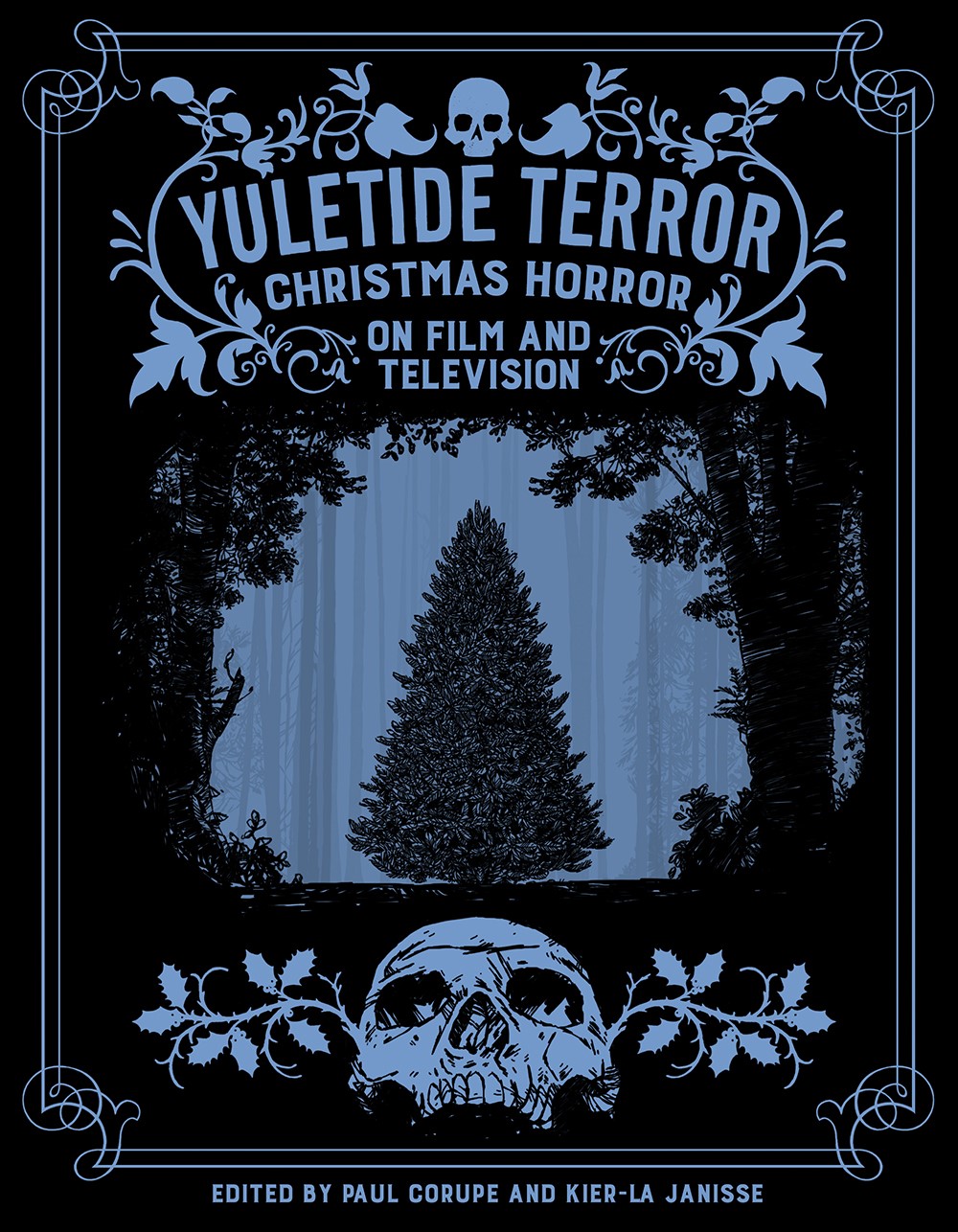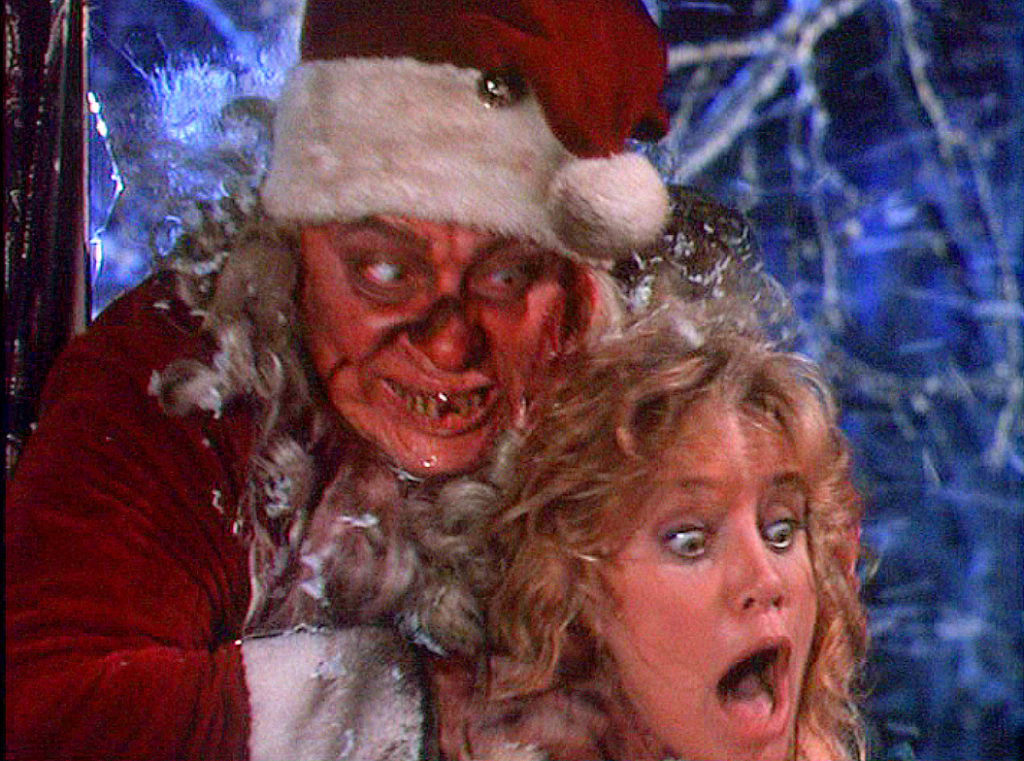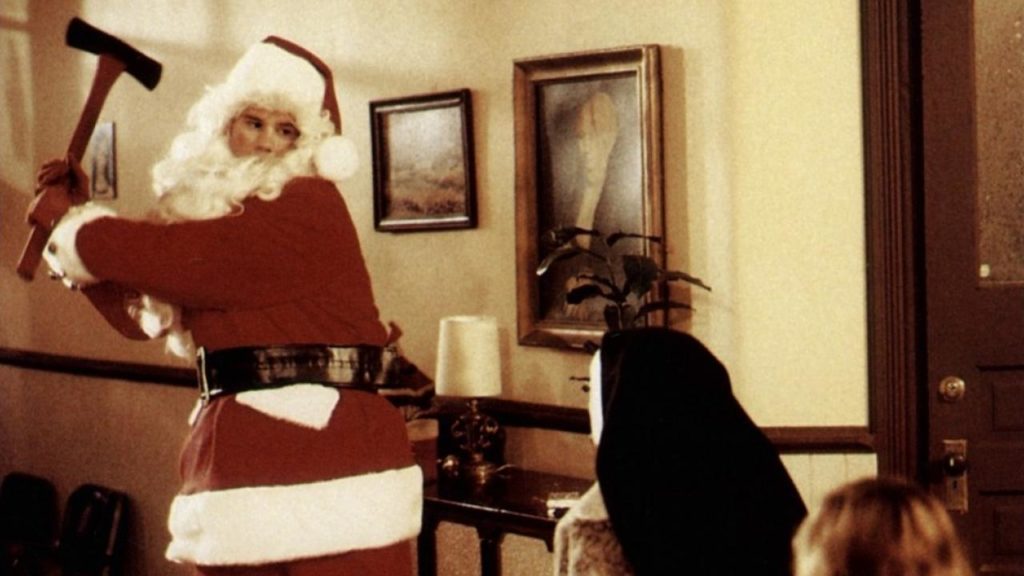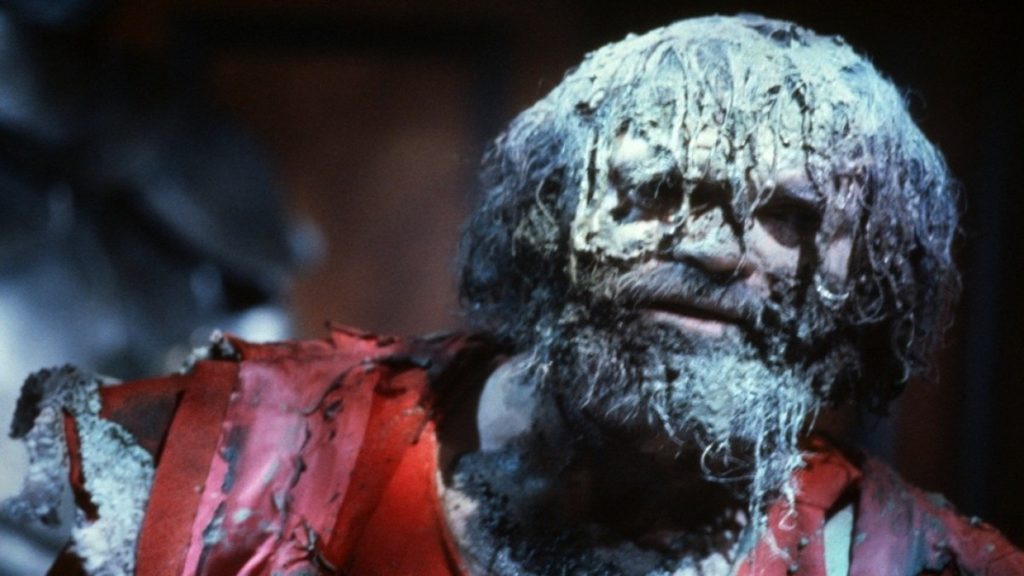
Like it or not, the holiday season is upon us, which means one thing: time to dust off your favorite seasonal entertainments for another orbit around the sun. But while many are content with the standards– your Mariah Careys, your Home Alones, your choice of Scrooges– others gravitate toward the darker side: killer snowmen, Santa-themed slashers, and ghosts of varying degrees of benevolence. Christmas-themed horror has provided almost enough counterprogramming to match the mainstream– so where to start?
Enter Spectacular Optical, the Canadian publisher responsible for such essential genre film compendiums as Kid Power! and Satanic Panic: Pop Cultural Paranoia in the 1980s. Their latest project is Yuletide Terror: Christmas Horror on Film and Television, which compiles 25 essays and interviews from writers across the globe on subjects from Santa Claus Conquers the Martians to Black Mirror, along with a directory of the finest seasonal shocks of movie and TV history. Spectacular Optical founder and genre-crit legend Kier-La Janisse will be on hand at the Brattle this Saturday for the official launch of Yuletide Terror, along with a screening of a brand new digital restoration of the evil snowman classic Jack Frost. We spoke to Kier-La about the history of holiday horror, the rebirth of the Krampus, and the surprising spiritual undertones of Gremlins.
BOSTON HASSLE: How did this project come about?
KIER-LA JANISSE: Well, it’s something that we’ve been planning for a couple of years, actually. For Spectacular Optical, we have– this is only our fourth book, so we’re still an emerging publisher. And we like doing anthology projects because it brings together a lot of writers who are more experienced with writers that are emerging, and bringing together all of their networks and their different levels of experience. So we knew we wanted to do another anthology project, and Christmas horror is just one of those things that horror fans love– frankly, there are over 250 movies in this book! There are tons of Christmas horror films, and there are other books that address Christmas horror for sure, but we wanted to do something that had more of an essay structure, and also had the compendium structure and operate as sort of a shopping guide, a quick reference guide. We wanted to have both of those things in one book. But, basically, my friend Paul Corupe, who’s my co-editor, and I will go for a drink and hang out, and that’s usually how all the ideas for what books we’re gonna do come out– from us hanging out and brainstorming.
BH: You mention the amount of movies there are in the genre. What do you think it is about Christmas that inspires all these horror movies?
KLG: Well, I think it’s a couple of things. For one thing, it’s a very, very old tradition– the tradition of horror for Christmas. Even before Christmas, per se, it was horror at winter time. There’s a big section in the book which deals with the British tradition in particular, and how Dickens, when he wrote A Christmas Carol, was actually tapping into a much older tradition which had already been going on for hundreds of years in England. Winter was always the main time for horror stories and ghost stories, not Halloween; they only actually started celebrating Halloween recently. So Christmas was always the time when there would be, originally, an oral tradition of people sitting around telling ghost stories, and then when radio came about there were always seasonal radio plays, and then broadcasting on television. This has always been a traditional staple of British television, with new horror films being made for the BBC premiering on television on Christmas Eve, as part of this idea of being gathered around in the cold and telling these stories.
But I think also, as the sort of modern idea of Christmas as something with Santa, and the presents, and the Christmas tree, and all of these things– again, most of these also came from much older traditions, but packaged up into what we know as the modern Christmas– as we started to have that kind of experience of Christmas, and the idea that it’s this time of good cheer and compassion and selflessness and sacrifice and family and being together, and all these good things, inevitably there was a cynicism about that that developed. Like, come on, most people are really grouchy around Christmastime! They’re pushing each other around in stores trying to get things that are on sale. The real behavior of people is the opposite of how people are supposed to think and feel at Christmastime. And so I think the Christmas horror film is a way of skewering a lot of these sort of phony ideals around Christmas. And they’re playing with an established image bank, so it’s really easy to make a Christmas horror film that will resonate with people, because people are familiar with all the images, they’re familiar with what they mean, and they’re familiar with the spiritual roots of that imagery. So it’s sort of like a shorthand for filmmakers, that they can make these kinds of films, and it will automatically have sort of a subtext built into it.
That’s one of the reasons there are so many of them, but I think also, now, the reason there’s so many– because there’s tons just in the last ten years or so– is because once we started to have the ‘80s [films], like Silent Night, Deadly Night and Christmas Evil, and Black Christmas a bit before that– we had some of these really major, important, influential Christmas horror films– and now filmmakers are of an age that they’re looking back at those films nostalgically. They’re not necessarily looking nostalgically back at this tradition that’s hundreds of years old, they’re looking at a tradition that’s from the ‘80s. And they’re actually making films that want to be part of that tradition. And so you get more and more Christmas horror films all the time because people know there’s a tradition, and they want to be part of it. So that just makes it so that it’s never-ending! A constant influx of Christmas horror films.
BH: And, of course, sort of the counterbalance to that– you have a number of essays in the book about the controversy that’s arisen after a lot of these have come out.
KLJ: Yes. Specifically Silent Night, Deadly Night, and Sint, in the Netherlands, Dick Maas’s film. I think those two films were the specific ones that were targeted the most with protests. And again, it was a lot of times normal people who were not necessarily horror fans who were affronted by this kind of imagery, and this idea of what they see as a benevolent character, like Santa, being made into a scary figure. It’s tantamount to a lot of the arguments now about there being a “War on Christmas!” People want their tradition, they want it preserved in a certain way and in a certain light. They don’t like that questioning. Because even though people feel like Christmas is ridiculous, I think people still want that ideal to be real.
BH: I read a book about EC Comics a while back, and the whole “…And All Through the House” controversy, where some people pointed out that Santa Claus is a saint, and this is sacrilege! Has anyone gone further than that and done a Nativity-themed horror film?
KLJ: Yeah, there’s actually a chapter in the book specifically about the Nativity. I feel like we could have gone way, way deeper into that. But we do have one writer [Dave Canfield], who’s actually a Christian writer– he used to be part of Jesus People USA for decades– and I sort of tapped him. I was like, “I want you to write the Nativity chapter!” (Laughs) I knew he would be really familiar with a lot of this. And so he talks about films like Gremlins as a Nativity film, which I had not thought of before, but when you read it you’re like, “Oh, yeah, it’s obvious!” And Inside, the French film. And he talks about– it’s not just the Nativity, it’s the whole idea of the Holy Family, the Mary-Joseph-Jesus trinity, and stuff like that. And so he has a chapter that deals with several films talking about this idea of unholy families, and mock-Nativities. I think that the Nativity is actually a really important narrative in Christmas horror. And that’s one of the things that he argues in the chapter, is that people look at Christmas horror as being sacrilegious, but actually a lot of it does rely on a lot of knowledge about things like the Nativity in order to work. It’s only because those myths are so common and known by people that they can make a film that riffs on that stuff, and that people can get it without having to be really didactic about it.
BH: Beyond the folkloric tradition of Christmas ghost stories, is there a particular flashpoint that you see as the first modern pop cultural Christmas horror?
KLJ: Well, I mean, Black Christmas is a huge one. And, as you mentioned, “…And All Through the House,” that EC Comics story– which was originally in Vault of Horror, it wasn’t even in Tales from the Crypt, but it became part of the Tales from the Crypt movie in the ‘70s, and then it was redone again for the HBO Tales from the Crypt series– that story in particular. People love that story! And it’s the kind of thing that I can see getting remade again and again. But I feel like that story, “…And All Through the House,” was really important, and Black Christmas was really important, and Silent Night, Deadly Night. Those are the three most important modern Christmas templates for what came after. And then, much more recently, we’ve started getting a lot more Krampus films. Krampus was a character who was not really in a lot of North American horror until about five years ago or so. And now Krampus has sort of taken on a really interesting role where he gets to be the evil Santa, so it’s sort of like you can pacify the people who don’t want to see Santa as a bad character by giving people Krampus instead.
BH: Were there any things from the different writers that you pulled in for this project brought up that you hadn’t heard of before?
KLJ: In terms of ideas, there’s a chapter on Christmas Evil which specifically talks about the medieval carnivals, and the idea of rituals around the Fool character, and [writer Florent Christol] writes about Christmas Evil in regard to that. And that chapter’s really interesting, because I thought that that was a super interesting approach to Christmas Evil that I had never considered.
One of the other things was a film called 3615 code Père Noël. Just when we started compiling lists of movies for the book was when I first heard of that film. I think it’s going to be one of the most popular chapters in the book, because we managed to track down the kid who is the lead [French actor Alain Lalanne]. It’s basically a film that came out the year before Home Alone, and it’s the same story, but it’s a horror movie! So, instead of it being funny that these people are trying to break into the house, it’s really scary! (laughs) And it’s this kid who is alone in the house, and there’s this guy who’s a mall Santa, and he’s been fired from his job, and this kid’s parents own the mall. And the kid has this computer. In France, they had the internet ten years before we did– they had this thing called Minitel, which was this really primitive form of internet. You could do sort of a really simple version of e-mail, and chat online with people and stuff. And so the mall Santa ends up on the mall’s Minitel computer terminal and gets ahold of this kid, and the kid thinks it’s Santa, so he tells the guy where he lives! And so then it’s just a kid defending himself and making booby traps and all this kind of stuff, just like Home Alone, as this Santa guy is trying to kill him.
With the help of a guy named Federico Caddeo, who is an Italian journalist who makes a lot of DVD featurettes, we got in touch with the kid from the film, who it turned out lived in Montreal. We went and interviewed him, and that’s in the book. And his dad, who directed the film [René Manzor], gave us all kinds of pictures. So I think that’s really nice, because it’s not a very well-known film that we have all these beautiful photos for, and an interview with the kid, and I think that’s pretty cool.
BH: Finally, if you had to pick one personal favorite Christmas horror piece, what do you think that would be?
KLJ: Black Christmas. Easy. (Laughs) Plus, I’m Canadian, too. It’s a total point of pride for many Canadians.
Jack Frost
1997
dir. Michael Cooney
89 min.
Kier-La Janisse will speak at the Yuletide Terror launch party and introduce Jack Frost (1997) Saturday, 12/9, 9:30pm @ Brattle Theatre
Click here for ticket info




